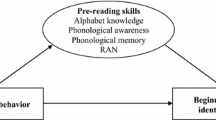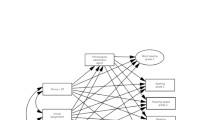Abstract
There appear to be beneficial effects of stimulant medication on daily classroom measures of cognitive functioning for Attention Deficit Disorder (ADD) children, but the specificity and origin of such effects is unclear. Consistent with previous results, 0.3 mg/kg methylphenidate improved ADD children's performance on a classroom reading comprehension measure. Using the Posner letting-matching task and four additional measures of phonological processing, we attempted to isolate the effects of methylphenidate to parameter estimates of (a) selective attention, (b) the basic cognitive process of retrieving name codes from permanent memory, and (c) a constant term that represented nonspecific aspects of information processing. Responses to the letter-matching stimuli were faster and more accurate with medication compared to placebo. The improvement in performance was isolated to the parameter estimate that reflected nonspecific aspects of information processing. A lack of medication effect on the other measures of phonological processing supported the Posner task findings in indicating that methylphenidate appears to exert beneficial effects on academic processing through general rather than specific aspects of information processing.
Similar content being viewed by others
References
Ackerman, P. T., Dykman, R. A., Holcomb, P. J., & McCray, D. S. (1982). Methylphenidate effects on cognitive style and reaction time in four groups of children.Psychiatry research, 7, 199–213.
Aman, M. G. (1978). Drugs, learning and the psychotherapies. In J. S. Werry (Ed.),Pediatrie psychopharmacology: The use of behavior modifying drugs in children (pp. 79–108). New York: Brunner Mazel.
American Psychiatric Association (1980).Diagnostic and Statistical Manual of Mental Disorders (3rd ed.). Washington DC: Author.
Ballinger, C. T., Varley, C. K., & Nolan, P. A. (1984). Effects of methylphenidate on reading in children with attention deficit disorder.American Journal of Psychiatry, 141, 1590–1593.
Barkley, R. A., & Cunningham, C. E. (1978). Do stimulant drugs improve the academic performance of hyperkinetic children?Clinical Pediatrics, 17, 85–92.
Bisanz, J., Danner, F., & Resnick, L. B. (1979). Changes with age in measures of processing efficiency.Child Development, 50, 132–141.
Bonig, R. (1978).Barnell Loft specific series. New York: Barnell Loft Ltd.
Borcherding, B., Thompson, K., Kruesi, M., Bartko, J., Rapoport, J. L., & Weingartner, H. (1988). Automatic and effortful processing in attention deficit/hyperactivity disorder.Journal of Abnormal Child Psychology, 16, 333–345.
Bremer, D. A., & Stern, J. A. (1976). Attention and distractibility during reading in hyperactive boys.Journal of Abnormal Child Psychology, 4, 381–387.
Campbell, S. B., Douglas, V. I., & Morgenstern, G. (1971). Cognitive styles in hyperactive children.Journal of Child Psychology and Psychiatry, 12, 55–67.
Conners, C. K. (1969). A rating scale for use in drug studies with children.American Journal of Psychiatry, 126, 884–888.
Conners, C. K., & Wells, K. C. (1986).Hyperkinetic children: A neuropsychosocial approach. Beverly Hills: Sage.
Douglas, V. I. (1983). Attentional and cognitive problems. In M. Rutter (Ed.),Behavioral syndromes of brain dysfunction in childhood (pp. 280–283). New York: Guilford Press.
Douglas, V. I., Barr, R. G., O'Neill, M. E., & Britton, B. G. (1986). Short-term effects of methylphenidate on the cognitive learning and academic performance of children with attention deficit disorder in the laboratory and in the classroom.Journal of Child Psychology and Psychiatry, 27, 191–211.
Douglas, V. I., Varr, R. G., Amin, K., O'Neill, M. E., & Britton, B. G. (1988). Dose effects and individual responsivity to methylphenidate in attention deficit disorder.Journal of Child Psychology and Psychiatry, 29, 453–475.
Dykman, R., Walls, R. C., Suzuki, T., Ackerman, P. T., & Peters, J. E. (1970). Children with learning disabilities: Condition differentiation and the effect of distraction.American Journal of Orthopsychiatry, 40, 766–782.
Fisk, A. D., & Schneider, W. (1981). Controlled automatic processing during tasks requiring sustained attention: A new approach to vigilance.Human Factors, 23, 737–750.
Fitzpatrick, P., Klorman, R., Brumaghim, J. T., & Keefover, R. W. (1988). Effects of methyl-phenidate on stimulus evaluation and response processes: Evidence from performance and event-related potentials.Psychophysiology, 25, 292–304.
Flintoff, M. M., Barron, R. W., Swanson, J. M., Ledlow, A., & Kinsbourne, M. (1982). Methylphenidate increases selectivity of visual scanning in children referred for hyperactivity.Journal of Abnormal Child Psychology, 10, 145–161.
Gittelman, R., & Kanner, A. (1986). Psychopharmacotherapy. In H. C. Quay and J. S. Werry (Eds.),Psychopathological disorders of childhood (3rd ed. pp. 455–494). New York: Wiley.
Just, M. A., & Carpenter, P. A. (1980). A theory or reading: From eye fixations to comprehension.Psychological Review, 87, 329–354.
Kahneman, D., & Treisman, A. (1984). Changing views of attention and automaticity. In R. Panasuraman & D. Davies (Eds.),Varieties of attention (pp. 29–61). New York: Academic Press.
Kaye, D. B. (1986). The development of mathematical cognition.Cognitive Development, 1, 157–170.
Lambert, N., & Sandoval, J. (1980). The prevalence of learning disabilities in a sample of children considered hyperactive.Journal of Abnormal Child Psychology, 9, 35–50.
Malone, M. A., Kershner, J. R., & Siegel, L. (1988). The effects of methylphenidate on levels of processing and laterality in children with attention deficit disorder.Journal of Abnormal Child Psychology, 16, 379–395.
Michael, R. L., Klorman, R., Salzman, L. F., Borgstedt, A. D., & Dainer, K. B. (1981). Normalizing effects of methylphenidate on hyperactive children's viglance performance and evoked potentials.Psychophysiology, 18, 665–677.
Peeke, S., Halliday, R., Callaway, E., Prael, R., & Reus, V. (1984). Effects of two doses of methylphenidate on verbal information processing in hyperactive children.Journal of Clinical Psychopharmacology, 4(2), 82–88.
Pelham, W. E. (1983). The effects of psychostimulants on academic performance in hyperactive and learning disabled children.Thalamus, 3, 1–47.
Pelham, W. E. (1986). The effects of psychostimulant drugs on learning and academic achievement in children with attention-deficit disorders and learning disabilities. In J. K. Torgesen & B. Y. L. Wong (Eds.),Psychological and educational perspectives on learning disabilities (pp. 259–295). Orlando: Academic Press.
Pelham, W. E., Atkins, M. S., Murphy, H. A., & Swanson, J. (1985).A teacher rating scale for the diagnosis of attention deficit disorder. Teacher norms, factor analyses, and reliability. Unpublished manuscript, Florida State University.
Pelham, W. E., Bender, M. E., Caddell, J. M., Booth, S., & Moorer, S. (1985). The dose-response effects of methylphenidate on classroom academic and social behavior in children with attention deficit disorders.Archives of General Psychiatry, 42, 948–952.
Pelham, W. E., & Hoza, J. (1987). Behavioral assessment of psychostimulant effects on ADD children. In R. Prinz (Ed.),Advances in behavioral assessment of children and families (Vol. 1, pp. 3–34). Greenwich, CT: JAI Press.
Pelham, W. E., Sturges, J., Hoza, J., Schmidt, C., Bijlsma, J., & Milich, R. (1987). Sustained release and standard meythlphenidate effects on cognitive and social behavior in children with attention deficit disorder.Pediatrics, 80, 491–501.
Peloquin, L. J., & Klorman, R. (1986). Effects of methylphenidate on normal children's mood, event related potentials, and performance in memory scanning and vigilance.Jouranl of Abnormal Psychology, 95, 88–98.
Posner, M. I., & Mitchell, R. F. (1967). Chronometric analysis of classification.Psychological Review, 74, 392–409.
Radosh, A., & Gittelman, R. (1981). The effect of appealing distractors on the performance of hyperactive children.Journal of Abnormal Child Psychology, 9, 179–189.
Rapport, M. D., Stoner, G. J., Birmingham, B. K., & Tucker, S. (1985). Methylphenidate in hyperactive children: Differential effects of dose on academic, learning and social behavior.Journal of Abnormal Child Psychology, 13, 227–244.
Reid, M. K., & Borkowski, J. G. (1984). Effects of methylphenidate on information processing in hyperactive children.Journal of Abnormal Child Psychology, 12, 169–186.
Schachar, R., Logan, O., Wachsmuth, R., & Chajczyk, D. (1988). Attaining and maintaining preparation: A comparison of attention in hyperactive, normal, and disturbed control children.Journal of Abnormal Child Psychology, 16, 361–378.
Schiffrin, R. M., & Schneider, W. (1977). Controlled and automatic processing. II. Perceptual learning, automatic attending, and a general theory.Psychological Review, 84, 127–190.
Solanto, M. (1984). Neuropharmacological basis of stimulant drug action in attention deficit disorder with hyperactivity: A review and synthesis.Psychological Bulletin, 3, 389–409.
Sostek, A. J., Buchsbaum, M. S., & Rapoport, J. L. (1980). Effects of amphetamine of vigilance performance in normal and hyperactive children.Journal of Abnormal Child Psychology, 8, 491–500.
Swanson, J. M., & Kinsbourne, M. (1979). The cognitive effects of stimulant drug and hyperactive children. In G. A. Hale & M. Lewis (Eds.),Attention and cognitive development (pp. 249–274). New York: Plenum Press.
Sykes, D. H., Douglas, V. I., Weiss, G., & Minde, K. K. (1971). Attention in hyperactive children and the effect of methylphenidate (Ritalin).Journal of Child Psychology and Psychiatry 12, 129–131.
Thurston, C. M., Sobol. M. P., Swanson, J., & Kinsbourne, M. (1979). Effects of methylphenidate (Ritalin) on selective attention in hyperactive children.Journal of Abnormal Child Psychology, 7, 741–781.
van der Meere, J. J., & Sergeant, J. A. (1988a). Focused attention in pervasively hyperactive children.Journal of Abnormal Child Psychology, 16, 627–639.
van der Meere, J. J., & Sergeant, J. A. (1988b). Controlled processing and vigilance in hyperactivity: Time will tell.Journal of Abnormal Child Psychology, 16, 641–655.
Wagner, R. K. (1986). Phonological processing abilities and reading: Implications for disabled readers.Journal of Learning Disabilities, 19, 623–630.
Wagner, R. K., & Torgesen, J. K. (1987). The nature of phonological processing and its causal role in the acquisition of reading skills.Psychological Bulletin, 101, 192–212.
Weingartner, H., Rapoport, J. L., Buchsbaum, M. S., Bunney, W. E., Ebert, P. M. H., Mikkelsen, E. J., & Caine, E. D. (1980). Cognitive processes in normal and hyperactive children and their response to amphetamine treatment.Journal of Abnormal Psychology, 89, 25–37.
Author information
Authors and Affiliations
Additional information
Preparation of this manuscript was supported by grant HD23340 from the National Institute of Child Health and Human Development and grant AA06267-03 from the National Institute on Alcohol Abuse and Alcoholism. Appreciation is expressed to Janet Kistner, Joseph Torgesen, and especially to Carol Rashotte for their valuable contributions. We also wish to thank Betty Brown and her staff at the Florida State University Computing Center for their assistance in data analysis.
Rights and permissions
About this article
Cite this article
Balthazor, M.J., Wagner, R.K. & Pelham, W.E. The specificity of the effects of stimulant medication on classroom learning-related measures of cognitive processing for Attention Deficit Disorder children. J Abnorm Child Psychol 19, 35–52 (1991). https://doi.org/10.1007/BF00910563
Revised:
Issue Date:
DOI: https://doi.org/10.1007/BF00910563




